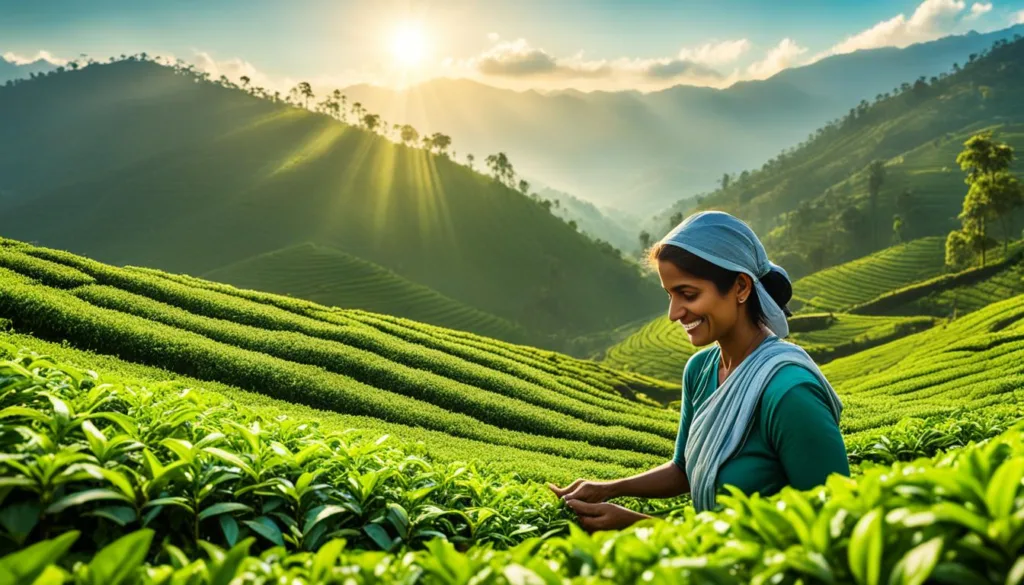Often coined as the ‘Pearl of the Indian Ocean’, Sri Lanka, with its seductive beaches, majestic wildlife, and verdant tea plantations, invites a yearning for exploration in every intrepid traveler. Yet, with such diverse attractions, when is the Best Time to Visit Sri Lanka? It’s not just about chasing endless summer—each period crafts a unique tapestry of experiences, be it basking on a sun-drenched coast or communing with nature’s giants. In this guide, we unveil essential Sri Lanka travel tips so your Sri Lanka vacation becomes a chronicle of perfection.
Whether you’re plotting a course for sun-kissed relaxation or an odyssey into the wilds, understanding When to go to Sri Lanka is pivotal. As monsoons dance across the island, creating pockets of paradise at different times, we navigate you through the seasons to spotlight Sri Lanka’s climatic symphony—the key to unlocking the island’s most celebrated experiences.
Key Takeaways
- Discerning the best seasons for Sri Lanka’s western and southern beaches, ideal from December to March, to plan the ultimate coastal getaway.
- Insight on the dry spells, crucial for witnessing the grandeur of Sri Lanka’s wildlife in their natural habitat.
- Integration of the cultural festival calendar into travel planning for an immersive local experience.
- Understanding the implications of the Maha and Yala monsoons on your travel itinerary.
- Embracing the shoulder season advantages like fewer crowds and pleasant weather conditions for activities such as hiking.
- Capturing the essence of Sri Lanka’s tea culture by timing your visit to coincide with the country’s optimal tea production periods.
Discovering Sri Lanka’s Climate and Travel Seasons
Enveloped by the warm Indian Ocean, Sri Lanka’s geographical positioning close to the equator gifts it with a delightful tropical climate that’s a major draw for visitors worldwide. Exploring this jewel island’s climate patterns and cultural events can greatly influence your Sri Lanka travel guide plans, ensuring you experience the best season to visit Sri Lanka.
Sri Lanka’s Year-Round Warmth and Seasonal Monsoons
Bathing in constant sunshine, the island’s coastline seems to bask perennially in temperatures hovering around 85 degrees Fahrenheit, conducive to leisure and Sri Lanka tourism. Yet, it is the island’s nuanced climate, shaped by the alternating monsoons, that beckons a deeper look. Understanding these patterns is essential for planning, as they affect the country’s different regions in various ways.
Regional Weather Patterns: Planning Your Itinerary
As you sketch your visit’s outline, it is crucial to factor in the central “dry zone” and the refreshingly cooler mountain areas, each with distinct climates and unique experiences. The monsoons—the southwest from May to September and the northeast from October to January—paint the weather landscape differently across the island, often dictating the best season to visit Sri Lanka for your desired activities.
| Region | Best Travel Period | Weather Characteristics |
|---|---|---|
| Southwest Coast | December – March | Dry, sunny season ideal for beaches |
| Central Dry Zone | June – September | Less humidity, better for exploring ancient cities |
| Mountainous Central Region | January – February | Clear skies, cool climate for hiking and tea plantation visits |
| North and Eastern Coast | May – September | Perfect escape from the southwest monsoon |
Embracing the Island’s Numerous Festivals and Events
Celebrations thread through the fabric of Sri Lanka’s culture, with festivities like Tamil Thai Pongal in January, Independence Day in February, and the Sinhala and Tamil New Year in April. These not only enhance the island’s charm but also offer unique opportunities for diving into its cultural heart. Plotting your travels around these cultural landmarks can greatly enrich your Sri Lanka tourism experience.
- January – Tamil Thai Pongal: Celebrate the harvest festival with the local communities.
- February – Independence Day: Join in the national commemorations and vibrant street parades.
- April – Sinhala and Tamil New Year: Witness traditional games and festive foods marking the new year.
Sri Lanka’s Pristine Beaches: Timing Your Coastal Retreat
When you’re seeking the Sri Lanka vacation of a lifetime, the lure of its golden sands and clear blue waters is undeniable. To soak in the most sun, the best time to visit Sri Lanka beaches depends largely on which coast you set your sights on. Knowing the seasonal climate that each of Sri Lanka’s beautiful coastlines offers can significantly enhance your seaside experience.

For a bold contrast in weather patterns and beach activities, we’ve drawn up a comparative glimpse of what each coast presents throughout the year – ensuring that your trip aligns with the sunny days and serene vibes you’re after.
| Coast | Peak Travel Season | Highlights | Recommended Beach Destinations |
|---|---|---|---|
| South and West | December to March | Vibrant beach resorts, Whale watching, Scuba diving | Hikkaduwa, Mirissa, Bentota |
| East | May to August | Tranquil beaches, Surfing, Cultural festivals | Arugam Bay, Pasikudah, Trincomalee |
On the south and west coasts, Hikkaduwa and Mirissa boast activities brimming with thrill and excitement as their coastal climates hit peak perfection during the winter months. Enjoy whale watching or delve beneath the waves to explore vibrant coral reefs. The east, with its quieter charm and warm waters, welcomes visitors to the surfers’ paradise of Arugam Bay, a place of idyll from the summer bustle elsewhere.
Regardless of when you plan to explore this tropical haven, indulging in Sri Lanka travel tips pertaining to the local climate can turn your beach-bound journey into an endless stretch of paradise. The island’s coastline, ripe with diverse experiences, beckons travelers year-round for a truly memorable retreat.
Wildlife in Sri Lanka: Elephants and Leopards Awaiting
For those drawn to the allure of Sri Lanka tourism, the island’s rich biodiversity provides unforgettable experiences. Sri Lanka wildlife watching is especially a draw for nature lovers, with ample opportunities for sighting majestic beasts in their natural habitats. Exploring the great outdoors on a Sri Lanka safari is not only about the adventure; it’s a journey into the heart of the island’s ecological wonders.
The Best Time to Visit Sri Lanka for Elephant Spotting
Renowned for its lush landscapes and robust wildlife, Sri Lanka especially shines when it comes to elephant spotting in Sri Lanka. Observing these gentle giants roaming freely is most rewarding during the dry season, from November to April, aligning with Minneriya National Park’s famous ‘The Gathering’. This spectacular event presents an ideal backdrop for photography and the appreciation of natural elephant behavior as they converge around water sources.
Safari Seasons: Merging Wildlife Watching with Ideal Weather
Choosing the right time for a safari can greatly enhance your wilderness adventure. The shoulder seasons, spanning from September to October and again in April, offer a sweet spot for wildlife enthusiasts to embark on safaris. It’s a period when the weather is agreeable across Sri Lanka for both animal sightings and comfortable expeditions.
| Season | Wildlife Watching Highlights |
|---|---|
| November – April | High elephant visibility at waterholes, ideal for safari tours |
| September | ‘The Gathering’ of elephants at Minneriya National Park |
| April | End of the dry season; increased chances of observing new-born elephants |
| September – October | Pleasant weather for park visits, fewer tourists, diverse animal activities |
Exploring the Verdant Tea Plantations of Sri Lanka
A Sri Lanka vacation is incomplete without a visit to the breathtaking tea plantations Sri Lanka is famed for. The central Hill Country, with its emerald tea-covered slopes, stands as a testament to the island’s rich agrarian heritage. For travelers yearning for serene landscapes and a taste of colonial history, these sprawling estates embody the essence of Sri Lankan beauty.

Timing Your Visit to the Hill Country’s Tea Estates
Discerning the best time to traverse the meandering paths amidst the tea bushes hinges on a balance of climate preferences and cultural experiences. While Sri Lanka travel tips often highlight the dry months of January to February as ideal, there is something uniquely enchanting about the June to September period, when the estates are at their most lush and vibrant.
Monsoon Effects on the Tea Plantation Experience
The Hill Country’s verdure is nourished by the monsoon rains, which can transform your visit into a magical misty adventure from May to September. This is when the tea plantations glisten with raindrops, and the countryside is alive with the sounds of gushing streams and rustling leaves. However, for those pondering when to go to Sri Lanka for clearer skies, the inter-monsoon months offer cooler and dryer trekking conditions perfect for an in-depth exploration of the tea culture.
- Dry Season (January to February, June to September): Ideal for clear views and long walks through the estates.
- Monsoon Season (May to September): Offers a unique atmosphere with mist-clad landscapes, although with wetter conditions.
Whether you arrive during the tranquil dry spells or the dynamic monsoon season, Sri Lanka’s tea plantations provide an unforgettable journey into the heart of the island’s most cherished export.
Conclusion
The intricate tapestry of climates and cultural events within Sri Lanka provides a vibrant backdrop against which travelers can craft an unforgettable journey. Whether a serene sun-soaked respite by the southern shores calls your name, or the fascinating venture of wildlife observation during the dry season ignites your spirit, each moment in Sri Lanka is poised to enrich your travel stories. An agile plan, informed by a reliable Sri Lanka travel guide and cognizant of seasonal nuances, unlocks the realm of experiences in this tropical paradise.
Recognizing the best time to visit Sri Lanka pivots not just on specific interests but also on embracing the island’s radiant ambiance. Whether it’s the bustling energy during festive seasons or the peaceful lull of the monsoon retreats, your journey can be tailored to witness the island’s distinguished landscapes and traditions in their prime. A traveler’s enjoyment flourishes when each distinctively timed activity, synchronizing with the mosaic of Sri Lanka weather patterns, is woven into the itinerary.
Ultimately, the essence of Sri Lanka tourism is the ability to offer adventures across any calendar month, catering to the whims of beach loungers, cultural enthusiasts, and nature lovers alike. There’s a perennial promise of discovery – a promise that’s held within the nation’s perennial warmth and vivacious spirit. Thus, with mindful planning and an adventurous heart, the island stands ready to reveal its myriad of wonders to those who seek them.






